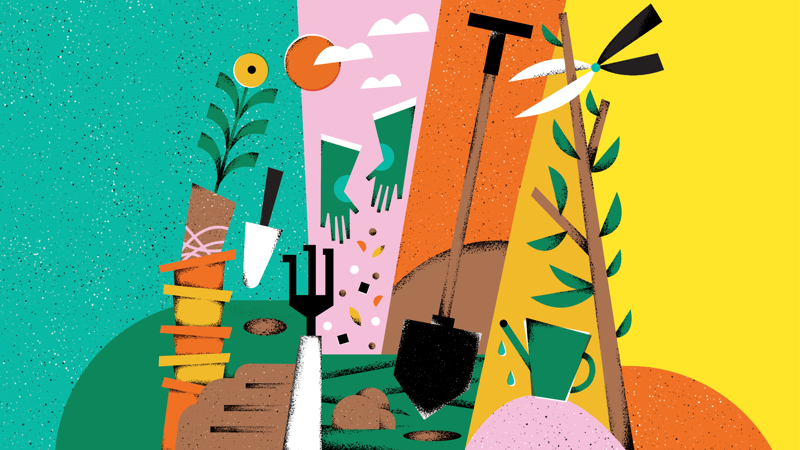
Tool it right
You’ll need
- Scrap paper
- Pens or pencils
- Plant pots
- Tree, plant or wildlife ID cards (optional)
Before you begin
- On scraps of paper, write out different gardening tasks and tools.
- Put a task in each plant pot and hide the names of tools around your meeting place (if you are running this part of the activity before the visit) or around the area you’re visiting (if they give you permission to do so).
- Check whether you need permission to visit the area you’ve chosen – some woodland is private, protected, or managed. You could get in touch with the governing body for the area to ask if you can visit or have a tour.
- Remind yourself of the Countryside Code, Scottish Outdoor Access Code, or Countryside Code NI.
- You could run I know yew and Good thymes in the garden before this session to introduce everyone to the topic and help them learn about some different kinds of trees and plants.
- It’s helpful to have some identification guides for this activity like NBHS’s guide to the non-native invasive plants of Britain.
Safety checklist
Use the safety checklist to help you plan and risk assess your activity. Additional coronavirus-related controls to think about may include:
- Set up a hand washing station that you can use throughout the session.
- Make sure people wash their hands before the game and again straight afterwards.
- Make sure everyone stays a safe distance apart at all times.
Use the right tool
- Everyone should talk about why we use tools in gardening.
-
- What sort of tools are there?
- How do they help us?
- Everyone should split into teams. Each team should take a plant pot with a task in it.
- Everyone should search for the tools they need for their gardening task.
- When a team has found all the tools they need, they should talk about them.
-
- What’s the purpose of each tool?
- Could any of the tools be dangerous?
- How can people stay safe when using that tool?
- Should they wear any particular clothing?
- When every team has had chance to discuss their tools, everyone should come back together to talk about their task and their ideas for keeping safe while doing it.
Trees and homes
- The person leading the activity should make sure everyone knows how to stay safe and protect the woodland or area they’re in.
- Split into teams of about six people.
- The person leading the activity should set boundaries, so everyone knows how far they can explore. They should also explain if there are any areas people need to be extra careful around (for example, roads, rivers, or ponds) or avoid entirely (for example, protected, private or dangerous areas).
- Everyone should explore the area. They should keep an eye out for interesting wildlife and habitats.
- Each group should record what they find so they can show others and learn more about it later. It’s up to them how they record it – they could draw or write.
- Before they leave the woodland or hedgerows, everyone should make sure they haven’t taken anything they shouldn’t have. They should also check that they haven’t left anything behind.
- Everyone should gather together somewhere they won’t disturb wildlife.
- Everyone should share their favourite finds and anything that surprised them.
What to change
- Now everyone’s identified the different plants and habitats, it’s time to look at what could be done to help maintain or improve the area.
- Everyone should get back into small groups and go back out to explore the area. This time, they should look at what work they could do to help the plants and wildlife that live there.
- Everyone should remember to think about the things that shouldn’t be touched too. Are there any good plants or existing wildlife habitats that they shouldn’t disturb?
- In their groups, everyone should think about some different tasks they could do to maintain the area and encourage more plants or wildlife to thrive. It could involve cutting back plants, or making sure that they stay as they are.
|
Gardening tasks |
Tools needed |
|
Dig a hole and plant a tree in it |
|
|
Prune a hedge |
|
|
Plant some seeds |
|
|
Weed the garden |
|
|
Harvest fruits and vegetables |
|
|
Water the garden |
|
- Gardening gloves: essential for gardening; not only to keep our hands clean, but to help us avoid cuts and grazes when using tools or working with spiky plants.
- Hand trowel: these are must-have tools. Almost like a very small shovel, you can use them to dig, turn the earth, or pull up stubborn weeds. You can also use them to transfer soil into pots when planting seedlings and bulbs.
- Secateurs: used for cutting and trimming thin branches and stems, and also to harvest small fruits and vegetables. Just like scissors, an adult should teach everyone how to use them safely and supervise throughout.
- Hand fork: used to turn, lift and loosen hard dirt and soil. It’s especially useful when weeding your garden as it helps to loosen weeds.
- Spade: used to dig deep holes, remove large weeds, move compost and cut through roots when digging.
- Watering can: we use these to water our flowers and plants. They can get very heavy when filled with water, so only fill with as much water as you are comfortable carrying.
Reflection
This activity was about developing practical skills. Why might it be useful to know which tool to use for a task in the garden? How can tools help people to complete gardening tasks? Why is it important to understand that tools can be dangerous? People could talk about why they need to handle tools safely, and what handling them safely means.
This activity was also about valuing the outdoors. Ask everyone to think about the different plants or habitats they found.
- Did the group find the kinds of plants and wildlife they were expecting to see?
- Did anyone see anything they’d never seen before?
- Did everyone remember to follow the countryside code during the activity too?
It was important that everyone made sure that they didn’t do any harm to the area. Did everyone do something to help during the visit? Maybe they picked up some litter or were careful not to step on any plants. Humans can have a big impact on different habitats, so it’s important to pay attention to our actions when we’re out too.
Safety
All activities must be safely managed. You must complete a thorough risk assessment and take appropriate steps to reduce risk. Use the safety checklist to help you plan and risk assess your activity. Always get approval for the activity, and have suitable supervision and an InTouch process.
- Outdoor activities
You must have permission to use the location. Always check the weather forecast, and inform parents and carers of any change in venue.
- Animals and insects
Be aware of the risks before interacting with animals. Be aware of anyone with allergies, and make alternative arrangements for them.
- Gardening and nature
Everyone must wash their hands after the activity has finished. Wear gloves if needed. Explain how to safely use equipment and set clear boundaries so everyone knows what’s allowed.
- Challenge the group to keep an especially close eye out for any invasive or non-native plants that they can find.
- If you know what species people are likely to find, why not challenge groups to find a list of animals and plants? You could also encourage people to identify what they find in a more detailed way, for example, looking into differences between species.
Make sure the woodland or area you visit is accessible for everyone. Forests with well-maintained footpaths or purpose-built roads may be more accessible than wild land.
All Scout activities should be inclusive and accessible.



